| dc.description.abstract | Since 2011, citrus Huanglongbing (HLB, ex-greening) disease has been detected in Los Chiles, Costa Rica, close to the Nicaraguan border, by the State Phytosanitary Service (Servicio Fitosanitario del Estado; SFE) and by TicoFrut’s Agricultural Diagnostic Laboratory (Arredondo-Bernal et al. 1999; SFE 2011). However, there has not been a formal scientific report confirming its presence by two independent methods, nor has there been an update on the spread of the disease to other parts of the country. Sweet orange (Citrus sinensis) trees in Los Chiles showing zinc deficiency, vein yellowing, blotchy mottle, and corky veins resembling HLB disease were sampled. Genomic DNA was extracted from leaf midrib and petiole, and Asian citrus psyllid (Diphorina citri) samples using DNeasy Plant, and Blood and Tissue extraction kits (Qiagen, Hilden, Germany). Quantitative polymerase chain reaction (qPCR; TaqMan probes) assays (Li et al. 2006) detected the presence of ‘Candidatus Liberibacter asiaticus’ in 30 symptomatic tree samples. The intergenic region between rplA and rplJ of the β-operon (Hocquellet et al. 1999) was amplified from eight plant and two psyllid samples containing five insects each, and was directly sequenced (Macrogen, Korea) to corroborate the presence of ‘Ca. L. asiaticus’. All sequences obtained from plants and D. citri shared 100% identity with each other, and a BLAST search showed a 99% identity to different sequences of ‘Ca. L. asiaticus’ available in GenBank, e.g., some from India (KC477384). Although D. citri is present in the country (Villalobos et al. 2005), the disease has not been detected in other growing areas. Three hundred seventeen trees and 32 psyllid samples were tested as described above for the presence of ‘Ca. L. asiaticus’ by qPCR in July through September 2013, and April through May 2014. Sampled trees were grown in the San Jose, Alajuela, and Puntarenas provinces, and showed chlorosis-like zinc deficiency. None of the samples tested positive for ‘Ca. L. asiaticus’. Ct values were above 36 or undetected, while internal control (COX) values ranged from 17 to 23. Considering that Costa Rica is a small country, the containment or the failure to detect ‘Ca. L. asiaticus’ in other regions was unexpected. This phenomenon can be due to the SFE’s and the private sector’s quarantine and containment plans (Arredondo-Bernal et al. 2013); however, there may be other factors that are containing the disease that have not been studied. © 2015 The American Phytopathological Society. | es |



